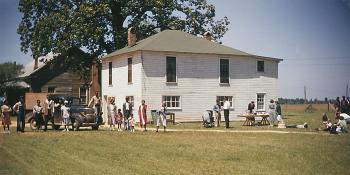
Preserving our past, building our future
On April 1, the Hargrett Rare Book and Manuscript Library at the University of Georgia officially announces the opening of the Habitat for Humanity International collection.
These records, available for research, document Habitat’s early history and development and consist of correspondence and files, photographs like the ones featured in this slideshow, newsletters, and artifacts. Habitat’s archives join related collections in the Hargrett Library including the Millard and Linda Fuller papers, the Fuller Center for Housing records, and the Clarence L. Jordan papers.
1
/
3

In 1942, Clarence Jordan and his wife Florence found Koinonia Farm, a small, interracial Christian community outside Americus, Georgia. Jordan — a farmer, Greek scholar and theologian — is often called the spiritual father of Habitat for Humanity.

Koinonia is the Greek word usually translated as “community” or “fellowship.” The farm community emphasizes equality, shared resources, and wise stewardship of land and natural resources.

At Koinonia, Jordan and Millard Fuller develop the concept of “partnership housing” — families in need of adequate shelter (but too poor to qualify for conventional home loans) building simple houses side by side with volunteers.

The houses are built with no profit added. Building is financed by a revolving Fund for Humanity. The fund is created by new homeowners’ house payments, no-interest loans provided by supporters and money earned by fundraising activities.

In 1973, Millard and Linda Fuller decide to apply the concept of partnership housing and the Fund for Humanity in developing countries, moving to Mbandaka, Zaire (now the Democratic Republic of Congo).

After three years of hard work to launch a successful house building program in Zaire, the Fullers return to the United States in 1976 to launch Habitat for Humanity International.

Much of the early work of establishing Habitat’s presence in countries around the world is carried out by volunteers, like these pictured in Kenya. Clive Rainey served as Africa director in Habitat’s early days.

Three walks in the first dozen years of Habitat’s existence help gain public attention, including this 700-mile walk from Americus to Indianapolis, Indiana, to mark Habitat’s seventh anniversary.

In their more than three decades of service, the Carters build all around the U.S. and in 14 other countries.

Two days after being named Habitat CEO, Jonathan Reckford helps raise the walls on our 200,000th house, joined in Knoxville, Tennessee, by interim CEO Paul Leonard and other volunteer builders.

In fiscal year 2014, Habitat for Humanity announces an important milestone. Since our founding in 1976, we have helped 1 million families improve their housing situations.
In 1942, Clarence Jordan and his wife Florence found Koinonia Farm, a small, interracial Christian community outside Americus, Georgia. Jordan — a farmer, Greek scholar and theologian — is often called the spiritual father of Habitat for Humanity.
Koinonia is the Greek word usually translated as “community” or “fellowship.” The farm community emphasizes equality, shared resources, and wise stewardship of land and natural resources.
At Koinonia, Jordan and Millard Fuller develop the concept of “partnership housing” — families in need of adequate shelter (but too poor to qualify for conventional home loans) building simple houses side by side with volunteers.
The houses are built with no profit added. Building is financed by a revolving Fund for Humanity. The fund is created by new homeowners’ house payments, no-interest loans provided by supporters and money earned by fundraising activities.
In 1973, Millard and Linda Fuller decide to apply the concept of partnership housing and the Fund for Humanity in developing countries, moving to Mbandaka, Zaire (now the Democratic Republic of Congo).
After three years of hard work to launch a successful house building program in Zaire, the Fullers return to the United States in 1976 to launch Habitat for Humanity International.
Much of the early work of establishing Habitat’s presence in countries around the world is carried out by volunteers, like these pictured in Kenya. Clive Rainey served as Africa director in Habitat’s early days.
Three walks in the first dozen years of Habitat’s existence help gain public attention, including this 700-mile walk from Americus to Indianapolis, Indiana, to mark Habitat’s seventh anniversary.
In their more than three decades of service, the Carters build all around the U.S. and in 14 other countries.
Two days after being named Habitat CEO, Jonathan Reckford helps raise the walls on our 200,000th house, joined in Knoxville, Tennessee, by interim CEO Paul Leonard and other volunteer builders.
In fiscal year 2014, Habitat for Humanity announces an important milestone. Since our founding in 1976, we have helped 1 million families improve their housing situations.